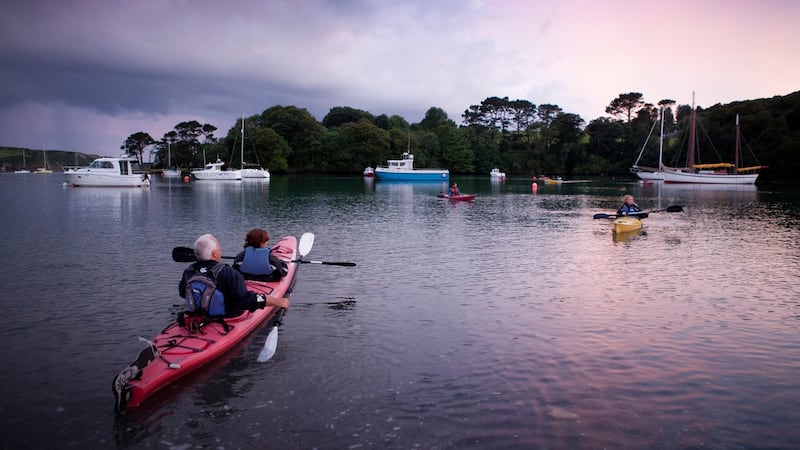The debate on how humans have lost their connection with nature continues. Yet anyone who goes hiking in the hills, swimming in the sea or even regularly walking in the park or along a river bank will know how that connection is very easily restored.
My daughter and I gained a strong sense of connecting with the natural world on a recent kayaking trip to the islands off the coast of west Cork.
The silences and the easy chat of being outdoors in a group of people you’ve just met is something that is shared among other groups – whether you’re hiking in the mountains or out on the open water.
The trip run by Atlantic Sea Kayaking was part of the annual Taste of West Cork Food Festival. Six hours long (with a stop off for a picnic lunch), it involved kayaking from Baltimore out around some of the islands in Roaring Water Bay.
Kayaking for this length of time might sound like an endurance test but as a novice kayaker, I can say that I managed fine and the guides at Atlantic Sea Kayaking made us feel very safe. In fact, Declan Power, one of the guides on our trip, says that that the vast majority of people they take out are beginners.

“We cater for people who have never kayaked before and even those who can’t swim. There is very little chance of you capsizing in these kayaks and if you do, you’ll just come back up to the surface straight away with your buoyancy aid and we’ll help you back into your boat,” says Power.
Paying close attention to individual needs and not venturing out in stormy weather are some of the basic rules. Power says they get kayakers of all ages who are mostly from Ireland. Americans, Canadians and British making up about three in every 10 participants. Trips are always cancelled in bad weather.
“The great thing about kayaking is that you’ll feel successful – and sometimes even heroic – after going out in a kayak. You couldn’t go out on a dinghy without some training in sailing,” adds Power.
On our trip in early September, we were lucky to have calm waters and a mild, if somewhat dull day. And one of the absolute joys of the slow paddling movement in the open water is the magical sense of timelessness you get. You also tend to forget about everything else when you’re out kayaking, such is the all-encompassing nature of the experience.
After a few minutes familiarising ourselves with our boats in Baltimore Harbour, we paddled out to Sherkin Island – a mere 10 minutes by ferry from Baltimore – passing the Baltimore Beacon to the south.
The water was a little choppy en route to Sherkin Island mainly due to the few motor boats and the Sherkin Island ferry, which passed us by. But skirting around Sherkin and some of the other so-called Hundred Isles of Carbery, we experienced gentle waters.

There was time for a quick look around the ruins of the Franciscan Friary on Sherkin before we’re back in our kayaks to continue out into Roaringwater Bay. The friary was built in 1450 by local chieftain, Fineen O’ Driscoll, who was notorious for smuggling, pirating and trading disputes with Waterford merchants.
We paddled around the north coast of Sherkin Island, passing Spanish Island, the smaller Sandy Island, The Catalogues and on to Heir Island, where we had our picnic lunch. We had a view of the wide estuary of the Ilen river on our way to Heir Island.
As the landscape of the islands is mostly rocky and grassy terrain, it’s hard to tell the difference between them on a first outing. It’s easy to understand how many of them are now uninhabited: In the 1800s, almost 5,000 people lived on these islands. Nowadays, there are a mere 250 inhabitants in total on Sherkin Island, Cape Clear Island, Heir Island and Long Island.
A pebble beach on Heir Island is our lunch location, and the long spindly strands of sea spaghetti make for a tasty starter. One member of the party explained how he gathers a bucket of serrated wrack at low tide for a seaweed bath from time to time – a cheaper option than the commercialised seaweed baths.

After lunch, we paddled back through a narrow channel, home to a colony of seals. Everywhere we looked, a seal was popping his/her head up out of the water or slithering into the water from their seaweed perch on one of the smaller islands. Looking at them out of the corner of your eye makes them feel less threatened and more inclined to come closer to our boats. Some obliged and this gentle interaction became one of the highlights of the trip.
On the homeward journey, the water got quite choppy due to rising winds and an outgoing tide. As we moved back into the open waters of Baltimore harbour, I found paddling more challenging and was glad to have a more experienced kayaker in my double kayak.
The connection with the sea left an intangible yet deep connection. Coupled with a pleasant sense of tiredness and satisfaction that can only be got from spending time outdoors, we set off on our long journey back to the east coast.
Atlantic Sea Kayaking, which was founded by champion kayaker Jim Kennedy 25 years ago, takes groups on full-day and half-day trips from both Baltimore Pier and Reen Pier (near Union Hall) through the summer months. They also take groups every evening from April to October to experience the bio-phosphorescence on the salt water tidal lake, Lough Hyne, a few kilometres inland from Baltimore.
Sylvia Thompson and her daughter were guests of Atlantic Sea Kayaking on the Baltimore and the Islands day trip during A Taste of West Cork Food Festival 2019. See atlanticseakayaking.com.












